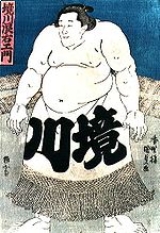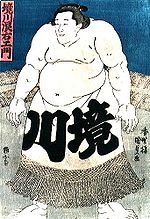
Sakaigawa Namiemon
Encyclopedia
Sakaigawa Namiemon was a sumo
wrestler from Ichikawa
, Chiba Prefecture
, Japan
. He was the sport's 14th Yokozuna.
 He made his debut in November 1857 and reached the top makuuchi
He made his debut in November 1857 and reached the top makuuchi
division in April 1867, then fighting under the name Masuizan. He won his first tournament championship in June 1868 from the maegashira ranks, emerging undefeated with eight wins. He was promoted to ozeki (then sumo's highest rank) in April 1870 after winning two tournaments in a row from the rank of sekiwake. Following his promotion, he changed his shikona
to Sakaigawa. The name had previously been used by another wrestler from the same stable, who had been an ozeki from 1857 to 1861.
Sakaigawa was initially given a yokozuna licence by the Osaka
based House of Gojo in February 1876. He was admitted as yokozuna by the House of Yoshida Tsukasa in February 1877. At that time, Meiji Restoration
was confusing the sumo world. Many sumo wrestlers were promoted to nominal yokozuna and the worth of name yokozuna stayed very low. Among them, Sakaigawa became the only yokozuna admitted officially.
Sakaigawa retired in January 1881. In the top makuuchi division, he won 118 bouts and lost 23 bouts, recording a winning percentage of 83.7. However, he also recorded 71 draws because he did not want to get the first attack. He was nicknamed "Tanikaze in Meiji".
*Championships from this period were unofficial
*Yokozuna were not listed as such on the ranking sheets until 1890
*There was no fusensho system until March 1927
*All top division wrestlers were usually absent on the 10th day until 1909
{| class="wikitable" style="font-size: 120%"
|-
!
!First
!Second
!Third
|-
|1867
|West Maegashira #6 (4-1-1-4draws)
|West Maegashira #4 (4-1-1-4draws)
|no tournament held
|-
|1868
|bgcolor=#66FF00|East Maegashira #2 (8-0-1-1draw)
|East Komusubi (4-2-1-3draws)
|no tournament held
|-
|1869
|bgcolor=#66FF00|East Sekiwake (8-0-1-1draw)
|bgcolor=#66FF00|East Sekiwake (7-0-1-2draw)
|no tournament held
|-
|1870
|bgcolor=#66FF00|East Ōzeki (6-0-2-2draws)
|East Ōzeki (6-1-1-2draws)
|no tournament held
|-
|1871
|East Ōzeki (5-0-2)
|bgcolor=#66FF00|East Ōzeki (6-0-2-1draw-1hold)
|no tournament held
|-
|1872
|East Ōzeki (4-1-1-4draws)
|East Ōzeki (3-1-1-5draws)
|no tournament held
|-
|1873
|East Ōzeki (6-0-1-3draws)
|East Ōzeki (3-2-2-3draws)
|no tournament held
|-
|1874
|East Ōzeki (4-1-1-3draws-1hold)
|East Ōzeki (6-1-1-2draws)
|no tournament held
|-
|1875
|East Ōzeki (4-1-2-3draws)
|no tournament held
|no tournament held
|-
|1876
|East Ōzeki (6-1-1-2draws)
|East Ōzeki (4-2-1-3draws)
|no tournament held
|-
|1877
|East Ōzeki (4-0-6)
|East Ōzeki (4-2-1-3draws)
|East Ōzeki (4-1-2-2draws-1hold)
|-
|1878
|East Ōzeki (3-1-2-3draws-1hold)
|no tournament held
|no tournament held
|-
|1879
|East Ōzeki (1-1-3-5draws)
|East Ōzeki (2-2-1-4draws-1hold)
|no tournament held
|-
|1880
|bgcolor=gray|Sat out due to injury
|East Ōzeki (2-1-4-3draws)
|no tournament held
|-
|1881
|bgcolor=gray|retired
!x
|no tournament held
|-
{|
| Green Box=Tournament Championship
|}
Sumo
is a competitive full-contact sport where a wrestler attempts to force another wrestler out of a circular ring or to touch the ground with anything other than the soles of the feet. The sport originated in Japan, the only country where it is practiced professionally...
wrestler from Ichikawa
Ichikawa, Chiba
is a city located in northwest Chiba, Japan, approximately 20 kilometers from the center of Tokyo. The city was founded on November 3, 1934. As of January 1, 2011, the city has an estimated population of 474,586 and a density of 8,259.42 persons per km². The total area is 57.46 km²...
, Chiba Prefecture
Chiba Prefecture
is a prefecture of Japan located in the Kantō region and the Greater Tokyo Area. Its capital is Chiba City.- History :Chiba Prefecture was established on June 15, 1873 with the merger of Kisarazu Prefecture and Inba Prefecture...
, Japan
Japan
Japan is an island nation in East Asia. Located in the Pacific Ocean, it lies to the east of the Sea of Japan, China, North Korea, South Korea and Russia, stretching from the Sea of Okhotsk in the north to the East China Sea and Taiwan in the south...
. He was the sport's 14th Yokozuna.
Career

Makuuchi
or is the top division of professional sumo. Its size is fixed at 42 wrestlers , ordered into five ranks according to their ability as defined by their performance in previous tournaments....
division in April 1867, then fighting under the name Masuizan. He won his first tournament championship in June 1868 from the maegashira ranks, emerging undefeated with eight wins. He was promoted to ozeki (then sumo's highest rank) in April 1870 after winning two tournaments in a row from the rank of sekiwake. Following his promotion, he changed his shikona
Shikona
A shikona is a sumo wrestler's ring name.As with standard Japanese names, a shikona consists of a 'surname' and a 'given' name, and the full name is written surname first. However, the given name is rarely used outside formal or ceremonial occasions. Thus, the former yokozuna Asashōryū Akinori is...
to Sakaigawa. The name had previously been used by another wrestler from the same stable, who had been an ozeki from 1857 to 1861.
Sakaigawa was initially given a yokozuna licence by the Osaka
Osaka
is a city in the Kansai region of Japan's main island of Honshu, a designated city under the Local Autonomy Law, the capital city of Osaka Prefecture and also the biggest part of Keihanshin area, which is represented by three major cities of Japan, Kyoto, Osaka and Kobe...
based House of Gojo in February 1876. He was admitted as yokozuna by the House of Yoshida Tsukasa in February 1877. At that time, Meiji Restoration
Meiji Restoration
The , also known as the Meiji Ishin, Revolution, Reform or Renewal, was a chain of events that restored imperial rule to Japan in 1868...
was confusing the sumo world. Many sumo wrestlers were promoted to nominal yokozuna and the worth of name yokozuna stayed very low. Among them, Sakaigawa became the only yokozuna admitted officially.
Sakaigawa retired in January 1881. In the top makuuchi division, he won 118 bouts and lost 23 bouts, recording a winning percentage of 83.7. However, he also recorded 71 draws because he did not want to get the first attack. He was nicknamed "Tanikaze in Meiji".
Top division record
*1-3 tournaments were held yearly in this period, though the actual time they were held was often erratic*Championships from this period were unofficial
*Yokozuna were not listed as such on the ranking sheets until 1890
*There was no fusensho system until March 1927
*All top division wrestlers were usually absent on the 10th day until 1909
{| class="wikitable" style="font-size: 120%"
|-
!
!First
!Second
!Third
|-
|1867
|West Maegashira #6 (4-1-1-4draws)
|West Maegashira #4 (4-1-1-4draws)
|no tournament held
|-
|1868
|bgcolor=#66FF00|East Maegashira #2 (8-0-1-1draw)
|East Komusubi (4-2-1-3draws)
|no tournament held
|-
|1869
|bgcolor=#66FF00|East Sekiwake (8-0-1-1draw)
|bgcolor=#66FF00|East Sekiwake (7-0-1-2draw)
|no tournament held
|-
|1870
|bgcolor=#66FF00|East Ōzeki (6-0-2-2draws)
|East Ōzeki (6-1-1-2draws)
|no tournament held
|-
|1871
|East Ōzeki (5-0-2)
|bgcolor=#66FF00|East Ōzeki (6-0-2-1draw-1hold)
|no tournament held
|-
|1872
|East Ōzeki (4-1-1-4draws)
|East Ōzeki (3-1-1-5draws)
|no tournament held
|-
|1873
|East Ōzeki (6-0-1-3draws)
|East Ōzeki (3-2-2-3draws)
|no tournament held
|-
|1874
|East Ōzeki (4-1-1-3draws-1hold)
|East Ōzeki (6-1-1-2draws)
|no tournament held
|-
|1875
|East Ōzeki (4-1-2-3draws)
|no tournament held
|no tournament held
|-
|1876
|East Ōzeki (6-1-1-2draws)
|East Ōzeki (4-2-1-3draws)
|no tournament held
|-
|1877
|East Ōzeki (4-0-6)
|East Ōzeki (4-2-1-3draws)
|East Ōzeki (4-1-2-2draws-1hold)
|-
|1878
|East Ōzeki (3-1-2-3draws-1hold)
|no tournament held
|no tournament held
|-
|1879
|East Ōzeki (1-1-3-5draws)
|East Ōzeki (2-2-1-4draws-1hold)
|no tournament held
|-
|1880
|bgcolor=gray|Sat out due to injury
|East Ōzeki (2-1-4-3draws)
|no tournament held
|-
|1881
|bgcolor=gray|retired
!x
|no tournament held
|-
- The wrestler's East/West designation, rank, and win/loss record are listed for each tournament.
- A third figure in win-loss records represents matches sat-out during the tournament
- an X signifies the wrestler had yet to reach the top division at that point in his career or a tournament after he retired
{|
| Green Box=Tournament Championship
|}
See also
- Glossary of sumo termsGlossary of sumo termsThe following words are terms used in sumo wrestling in Japan. azukari : Hold. A kind of draw. After a mono-ii, the gyōji or the shimpan "holds" the result if it was too close to call...
- List of past sumo wrestlers
- List of yokozuna

